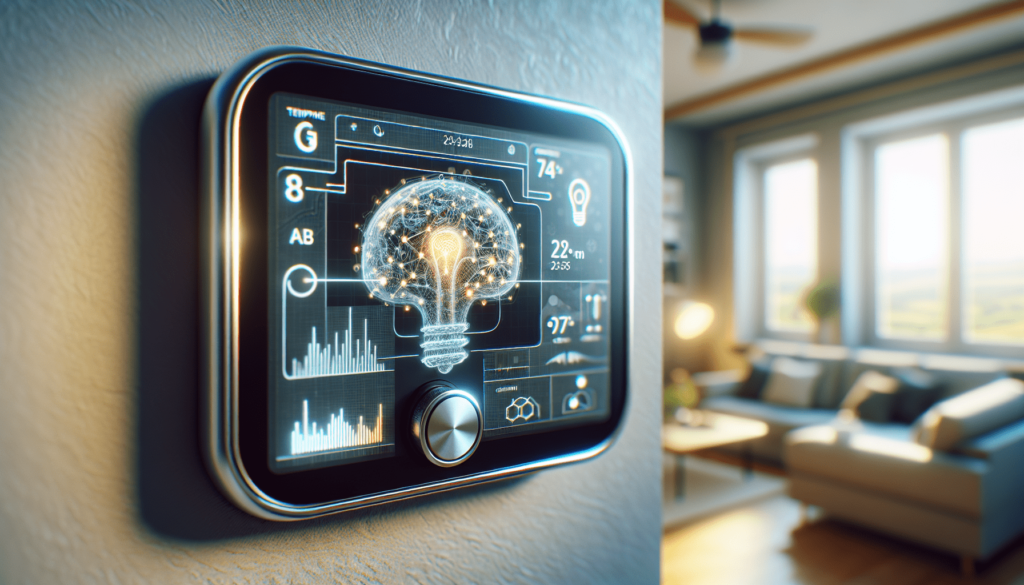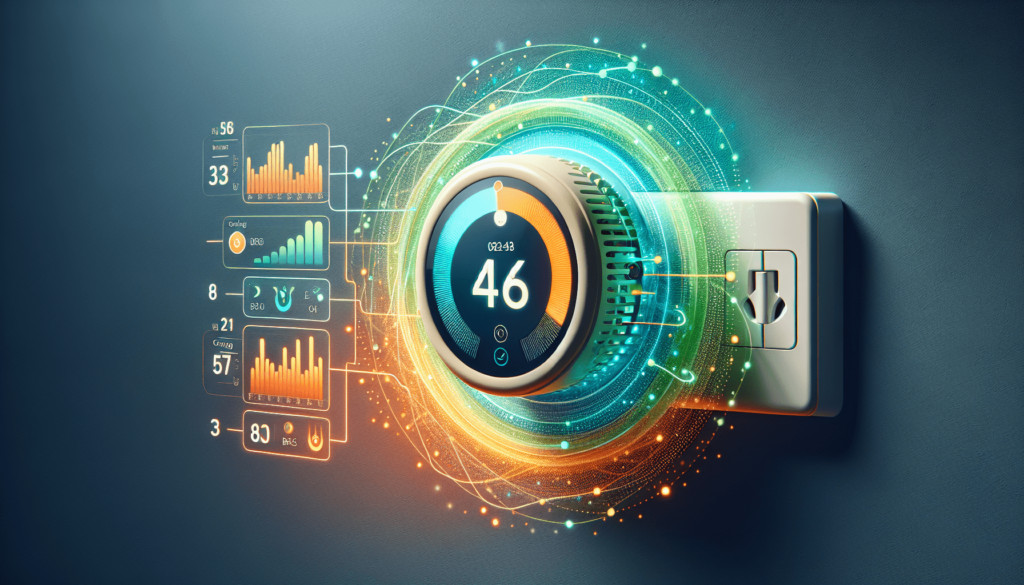Have you ever wondered if there are smart thermostats available that can learn your heating and cooling preferences? The answer is yes! Smart thermostats are designed to adapt to your lifestyle and create personalized temperature settings based on your daily routine. With advanced technology and machine learning capabilities, these innovative devices can analyze your patterns and adjust the temperature accordingly to provide the ideal comfort level in your home. Say goodbye to manual adjustments and hello to a more efficient and customized heating and cooling experience.

Smart Thermostats with Learning Capabilities
Introduction to smart thermostats with learning capabilities
Smart thermostats with learning capabilities are innovative devices that can not only control and adjust the temperature in your home but also learn your heating and cooling preferences over time. These intelligent devices utilize advanced algorithms and machine learning techniques to understand your behavior and adapt their settings accordingly. By learning your habits and preferences, these thermostats can provide personalized comfort, optimize energy usage, and ultimately enhance the overall efficiency of your HVAC system.
How smart thermostats learn
Smart thermostats learn your heating and cooling preferences through a combination of data analysis, pattern recognition, and user inputs. They continuously monitor and analyze factors such as occupancy, weather patterns, and manual adjustments to create a profile of your usage patterns. By understanding when you are home, what temperatures you prefer, and how your HVAC system responds to different conditions, these thermostats can adapt their settings to optimize both comfort and energy efficiency.
Benefits of smart thermostats with learning capabilities
There are numerous benefits to using smart thermostats with learning capabilities in your home. Firstly, these devices can significantly improve energy efficiency by automatically adjusting the temperature based on your preferences and usage patterns. This can lead to significant cost savings on your energy bills and also reduce your carbon footprint. Additionally, smart thermostats provide increased comfort and convenience by maintaining a consistent temperature in your home, even when you are away. They also offer remote control capabilities, allowing you to adjust settings from anywhere using a mobile app or integrated smart home systems. Overall, smart thermostats with learning capabilities offer a smart and efficient solution for modern heating and cooling needs.
Popular Smart Thermostats with Learning Features
Nest Learning Thermostat
The Nest Learning Thermostat is one of the most popular smart thermostats on the market known for its learning capabilities. It uses advanced algorithms and sensors to adapt to your schedule, learning your preferred temperatures and habits. With its sleek design and intuitive interface, the Nest Learning Thermostat seamlessly integrates with your lifestyle and provides energy-saving features such as auto-scheduling and energy usage monitoring.
Ecobee SmartThermostat
The Ecobee SmartThermostat is another highly regarded smart thermostat with learning capabilities. It utilizes advanced machine learning algorithms to understand your heating and cooling preferences and automatically adjusts the temperature based on occupancy and weather conditions. Additionally, the Ecobee SmartThermostat offers voice control through integrated voice assistants and advanced sensors for enhanced efficiency.
Honeywell Home T9
The Honeywell Home T9 is a smart thermostat that combines learning capabilities with a user-friendly interface. It learns your heating and cooling preferences through its intelligent algorithms and also takes into account occupancy patterns. The Honeywell Home T9 can be easily integrated with other smart home devices, providing a seamless experience and allowing for further customization and control.
Emerson Sensi Touch
The Emerson Sensi Touch is a feature-rich smart thermostat that incorporates learning capabilities to provide personalized comfort. With its adaptive algorithms, the Sensi Touch learns your preferred temperatures, schedules, and habits, and automatically adjusts settings to optimize energy usage. It also offers extensive compatibility with various HVAC systems, making it a versatile choice for homeowners.
Google Nest Thermostat E
The Google Nest Thermostat E is an affordable option that still provides learning capabilities. It adapts to your heating and cooling preferences and offers energy-saving features such as smart scheduling and the ability to control settings through a mobile app. The Nest Thermostat E is known for its simple installation process and sleek design, making it a popular choice among homeowners.

Key Features of Smart Thermostats with Learning Capabilities
Adaptive learning algorithms
Smart thermostats with learning capabilities employ adaptive learning algorithms to understand your heating and cooling preferences. These algorithms continuously analyze data from your HVAC system, weather conditions, and occupancy patterns to generate insights and adapt their settings accordingly. By adapting to your habits, these thermostats can provide personalized comfort while optimizing energy efficiency.
Behavioral pattern recognition
Behavioral pattern recognition is another key feature of smart thermostats with learning capabilities. These thermostats analyze your usage patterns over time to identify trends and adjust settings accordingly. By recognizing patterns in your behavior, the thermostat can anticipate your heating and cooling needs, ensuring a comfortable environment when you are home and conserving energy when you are away.
Auto-scheduling and temperature adjustments
One of the main benefits of smart thermostats with learning capabilities is their ability to automatically schedule and adjust temperatures. These thermostats can create personalized schedules based on your habits, ensuring that your home is always at the desired temperature when you need it. They can also adjust temperatures based on occupancy and weather conditions, maximizing comfort and energy efficiency.
Energy usage monitoring
Smart thermostats with learning capabilities provide energy usage monitoring features that allow you to track and analyze your HVAC system’s energy consumption. By having visibility into your energy usage, you can identify areas where energy is being wasted and make adjustments to optimize efficiency. This not only helps reduce your energy bills but also contributes to reducing your environmental impact.
Remote control and integration with smart home systems
Another key feature of smart thermostats with learning capabilities is their ability to be remotely controlled and integrated with smart home systems. With a mobile app or smart home integration, you can adjust your thermostat settings from anywhere, providing convenience and flexibility. Integration with other smart devices also allows for enhanced automation and control of your heating and cooling system.
How Smart Thermostats Learn Your Preferences
Initial setup and manual adjustments
Smart thermostats with learning capabilities begin by learning your preferences during the initial setup process. During this setup, you may be prompted to provide information such as your preferred temperature, occupancy patterns, and daily routine. These initial inputs allow the thermostat to establish a baseline understanding of your preferences. Additionally, you can manually adjust the temperature and settings as needed, and the thermostat will begin to learn and adapt to your manual adjustments over time.
Monitoring and analyzing usage patterns
Once the initial setup is complete, smart thermostats with learning capabilities continuously monitor and analyze your usage patterns. They track factors such as occupancy, temperature changes, and manual adjustments to create a profile of your habits and preferences. By analyzing these patterns, the thermostat can anticipate your needs and adjust settings accordingly to provide optimal comfort.
Taking into account occupancy and weather data
Smart thermostats with learning capabilities also take into account occupancy and weather data when learning your preferences. By monitoring occupancy factors, such as movement and activity in your home, the thermostat can determine when you are most likely to need heating or cooling. Additionally, by considering weather data from local sources or through internet connectivity, the thermostat can adjust settings based on external conditions, ensuring comfort and energy efficiency.
Utilizing feedback and user inputs
One important aspect of how smart thermostats learn your preferences is through feedback and user inputs. If the thermostat makes an adjustment that you find uncomfortable or not to your liking, you can provide feedback or manually adjust the settings. Over time, the thermostat will learn from this feedback and use it to refine its algorithms and better meet your comfort needs. User inputs, such as adjusting the temperature manually, are also taken into account and influence the thermostat’s learning process.

Advantages of Smart Thermostats Learning Your Preferences
Improved energy efficiency
One of the significant advantages of smart thermostats learning your preferences is improved energy efficiency. By adapting to your heating and cooling habits, these thermostats can optimize energy usage and minimize waste. They can identify periods of low occupancy and adjust the temperature accordingly to conserve energy. Over time, this can result in substantial energy savings, leading to lower utility bills and reduced environmental impact.
Increased comfort and convenience
Smart thermostats that learn your preferences provide increased comfort and convenience. By understanding your desired temperatures, schedules, and occupancy patterns, these thermostats can ensure that your home is always at the optimal temperature when you need it. They can automatically adjust temperatures based on your habits and preferences, eliminating the need for manual adjustments and providing a seamless and comfortable living environment.
Cost savings on energy bills
The learning capabilities of smart thermostats can lead to significant cost savings on energy bills. By optimizing energy usage and reducing waste, these thermostats can help lower your monthly utility expenses. They can identify inefficient patterns, such as heating or cooling an unoccupied home, and adjust settings accordingly to minimize energy consumption. Additionally, some smart thermostats provide energy usage monitoring features, allowing you to track and analyze your energy consumption to further identify areas for potential savings.
Reduced environmental impact
Smart thermostats that learn your preferences contribute to reduced environmental impact. By optimizing energy usage and reducing waste, these devices help conserve energy resources and reduce greenhouse gas emissions. Furthermore, by providing insights into your energy consumption, smart thermostats encourage more conscious and sustainable energy usage habits, contributing to a greener and more sustainable future.
Flexibility for different schedules and preferences
Smart thermostats with learning capabilities offer flexibility to accommodate different schedules and heating and cooling preferences. Whether you have a consistent daily routine or irregular occupancy patterns, these thermostats can adapt and adjust settings accordingly. They can learn and anticipate changes in your routine over time, ensuring that your home is always at the desired temperature no matter your schedule. This flexibility enhances comfort and convenience while maximizing energy efficiency.
Considerations When Choosing a Smart Thermostat with Learning Capabilities
Compatibility with your HVAC system
When choosing a smart thermostat with learning capabilities, it is important to consider compatibility with your HVAC system. Not all thermostats are compatible with every type of heating and cooling system. Before purchasing a smart thermostat, ensure that it is compatible with your specific HVAC system to avoid any compatibility issues during installation.
Integration with smart home devices
If you have other smart home devices or automation systems, consider the integration capabilities of the smart thermostat. Look for compatibility with popular smart home platforms such as Apple HomeKit, Google Assistant, or Amazon Alexa. Integration allows for seamless control and automation of your entire smart home ecosystem, enhancing convenience and functionality.
User-friendly interface and mobile app
A user-friendly interface and mobile app are crucial for a positive experience with your smart thermostat. Look for a thermostat with an intuitive interface that is easy to navigate and understand. A well-designed mobile app can provide additional control and convenience, allowing you to adjust settings, monitor energy usage, and receive alerts from anywhere with an internet connection.
Privacy and data security
As with any smart device, privacy and data security are important considerations. Ensure that the smart thermostat you choose has robust privacy measures in place to protect your personal information and usage data. Look for certifications or security features that indicate a commitment to data protection, and be sure to review the manufacturer’s privacy policy before making a purchase.
Support and warranty
Lastly, consider the support and warranty offered by the manufacturer. Look for a smart thermostat that comes with a warranty to provide peace of mind in case of any defects or issues. Additionally, check if the manufacturer provides comprehensive customer support, preferably through multiple channels such as phone, email, and online chat.

Installation and Setup Process
Professional installation vs. DIY installation
When it comes to installation, smart thermostats with learning capabilities offer both professional installation and DIY installation options. Professional installation ensures that the thermostat is correctly installed and integrated with your HVAC system, but it may come at an additional cost. DIY installation allows you to install the thermostat yourself, often with step-by-step instructions provided by the manufacturer. Consider your technical skills and comfort level when deciding which installation method is right for you.
Connection to your home Wi-Fi network
To maximize the capabilities of a smart thermostat with learning features, a stable and reliable Wi-Fi connection is essential. During the setup process, the thermostat needs to connect to your home Wi-Fi network to enable remote control, access firmware updates, and interact with other smart home devices. Ensure that your Wi-Fi network has good coverage and signal strength in the area where the thermostat will be installed.
Configuration and customization options
Configuration and customization options allow you to tailor the thermostat to your specific needs and preferences. During the setup process, you will typically have the opportunity to configure settings such as preferred temperatures, scheduling, and energy-saving features. Take the time to familiarize yourself with the available options and adjust them to suit your lifestyle and comfort requirements.
Initial programming and device pairing
To begin the learning process, you will need to program the initial settings of your smart thermostat. This typically involves entering your desired start and end temperatures, scheduling preferences, and other relevant information. After the initial programming, the thermostat will start learning your habits over time through its algorithms and sensors. Depending on the model, you may also need to pair the thermostat with other devices or sensors for enhanced functionality or automation.
Tips for Maximizing the Learning Capabilities of Your Smart Thermostat
Provide regular feedback on comfort levels
To ensure that your smart thermostat is meeting your comfort needs, it is helpful to provide regular feedback on the temperature and overall comfort levels in your home. If you find that the thermostat consistently adjusts temperatures in a way that is uncomfortable for you, provide feedback through the mobile app or thermostat controls. This feedback allows the thermostat to adapt and provide a more tailored experience.
Make use of occupancy sensors
Utilize the occupancy sensors in your smart thermostat to maximize its learning capabilities. These sensors detect movement and activity in your home, allowing the thermostat to understand when you are present or away. By leveraging this information, the thermostat can adjust temperatures accordingly, conserving energy when you are not home and ensuring comfort when you return.
Utilize the mobile app and remote control options
Take full advantage of the mobile app and remote control options provided with your smart thermostat. These features allow you to adjust settings, monitor energy usage, and receive alerts from anywhere. By utilizing the mobile app, you can provide feedback on comfort levels, make adjustments on the go, and ensure that your thermostat is fully optimized for your needs.
Update your preferences when needed
As your habits and preferences may change over time, it is important to update your preferences in the smart thermostat settings when necessary. For example, if your daily routine shifts or your desired temperature preferences change, update the settings to reflect these changes. This ensures that the thermostat continues to learn and adapt to your evolving needs.
Take advantage of energy-saving features
Smart thermostats with learning capabilities often provide energy-saving features that can help optimize energy usage and reduce waste. Take advantage of these features by enabling energy-saving modes, scheduling and adjusting temperatures based on occupancy patterns, and utilizing other automation options. By leveraging these energy-saving features, you can further enhance the efficiency of your HVAC system and reduce your environmental impact.

Common FAQs about Smart Thermostats with Learning Capabilities
Can smart thermostats save me money?
Yes, smart thermostats with learning capabilities can save you money. By automatically adjusting temperatures based on your habits and preferences, these thermostats optimize energy usage and reduce waste. This can lead to significant cost savings on your energy bills over time.
Do smart thermostats work with all HVAC systems?
Smart thermostats may not work with all HVAC systems. Compatibility varies depending on the specific model and manufacturer. Before purchasing a smart thermostat, check the compatibility requirements to ensure that it will work with your HVAC system.
What happens if I move or change my HVAC system?
If you move or change your HVAC system, you may need to reconfigure or replace your smart thermostat. Some thermostats can be easily uninstalled and reinstalled in a new location or with a different HVAC system. However, compatibility should be confirmed to ensure proper functionality.
Can I still manually adjust the temperature with a smart thermostat?
Yes, you can still manually adjust the temperature with a smart thermostat. While the thermostat learns your preferences and adjusts settings automatically, you always have the option to manually override the settings and make adjustments as needed.
How secure is the data collected by smart thermostats?
Smart thermostat manufacturers take data security and privacy seriously. Most reputable manufacturers use encryption and other security measures to protect the data collected by smart thermostats. However, it is always recommended to review the manufacturer’s privacy policy and consider any additional security measures you can take, such as regularly updating passwords and keeping your Wi-Fi network secure.
The Future of Learning Thermostats
Artificial intelligence advancements
The future of learning thermostats holds exciting possibilities with advancements in artificial intelligence (AI). AI-powered thermostats can further improve learning capabilities by analyzing a wider range of data points, using advanced machine learning algorithms, and adapting to individual preferences even more accurately.
Integration with renewable energy sources
As the world shifts towards renewable energy sources, learning thermostats can play a crucial role in optimizing energy usage and integrating with renewable energy systems. These thermostats can learn to prioritize the use of clean energy sources and adjust temperatures based on the availability of renewable energy, contributing to a more sustainable and greener future.
Increased interconnectivity with other smart devices
Learning thermostats of the future are likely to have increased interconnectivity with other smart devices in your home. This would allow for seamless automation and control across multiple devices and systems. For example, a learning thermostat could communicate with smart blinds or lighting systems to optimize energy usage and home comfort based on various factors.
Enhanced customization and personalization
The future of learning thermostats will focus on enhanced customization and personalization. These thermostats will learn not only your temperature preferences but also other factors such as humidity levels, air quality, and individual comfort preferences. This will result in a more tailored and personalized home environment.
Improved energy grid integration
Learning thermostats can play a significant role in future energy grid integration. By communicating with energy grid systems, these thermostats can adjust temperatures and energy usage based on demand response signals or time-of-use pricing. This integration can help balance the energy grid and optimize overall energy consumption.
In conclusion, smart thermostats with learning capabilities offer numerous benefits, including improved energy efficiency, increased comfort and convenience, cost savings, reduced environmental impact, and flexibility. When choosing a smart thermostat, consider factors such as compatibility, integration with other smart home devices, user-friendly interface, privacy and data security, and support and warranty. The installation and setup process can be done professionally or as a DIY project, and tips for maximizing the learning capabilities of your smart thermostat include providing regular feedback, utilizing occupancy sensors, making use of the mobile app, updating preferences when needed, and taking advantage of energy-saving features. Smart thermostats have the potential to save you money, but compatibility with your HVAC system should be confirmed. It is also important to review the data security measures implemented by the manufacturer. The future of learning thermostats holds exciting possibilities, including advancements in artificial intelligence, integration with renewable energy sources, increased interconnectivity with other smart devices, enhanced customization and personalization, and improved energy grid integration. With the right smart thermostat, you can experience enhanced comfort, convenience, and energy efficiency in your home.










